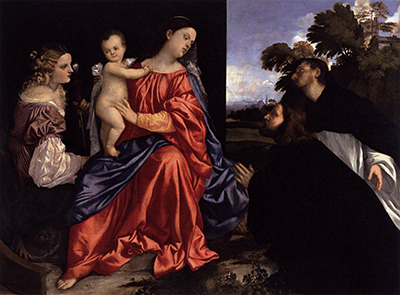Madonna paintings depict the Virgin Mary, and she is usually in the company of the baby Jesus. This particular painting was crafted by Tiziano Vecelli, commonly known as Titian. It was painted between 1512 and 1516 which was the period when Titan was developing his monumental style of art.
Giorgione and Giovanni Bellini, his former rivals, had recently died, and that allowed him to take his place as the head of the Venetian school of art. Madonna and Child with Sts Catherine and Dominic and a Donor was one of the many Madonna works by Titian. It depicted the Virgin Mary with her baby and is thus religious in nature. Titian is particularly known to have been strongly influenced by Christianity and mythology. This painting displayed one of Titian’s biggest strengths- the ability to place the Madonna in a non-central position while still maintaining her as the main figure of interest. In the picture, she is seen on an upper diagonal line facing two men. The picture also stood out because it had a visual element of movement, and this was quite rare in the High Renaissance era of art.
This Madonna picture was painted using the oil on canvas technique. It simply involved the use of a pigment, paint, and thinner. The oil works as the binder in these pictures, and it makes it easier to apply the paint to the brush. In Titian’s day, artists had to make their own oil paint. They had to know the properties of the pigments and the exact proportions to use. The quality of the mixture greatly determined the appearance and quality of the final picture. Therefore, making of oil paint was part of the skill set of a High Renaissance artist.
Oil painting offered many advantages to Titian and other great artists of his time. It provided more flexibility and depth of colour to the paintings. Since the paint took longer to dry, the artists could work on the paintings for extended periods. They had more time to layer and blend the pictures properly. The technique was not developed in Europe- it was first used in the Far East at the time when Buddhism was spreading. It was only until the Renaissance era that European artists discovered the benefits of the technique, and this was when it grew to become the standard painting method in the region.
Madonna paintings have been used in the Catholic church since the 2nd or 3rd century. The name ‘Madonna’ was only adopted in the 17th century, and it refers to images that are focused on the Virgin Mary. The term is mainly used when referring to works by High Renaissance artists. In many of these paintings, the virgin mother is depicted with her child Jesus. Some of the paintings don’t just involve static images- they tell a story. For example, they can illustrate Biblical scenes involving the Virgin mother.




